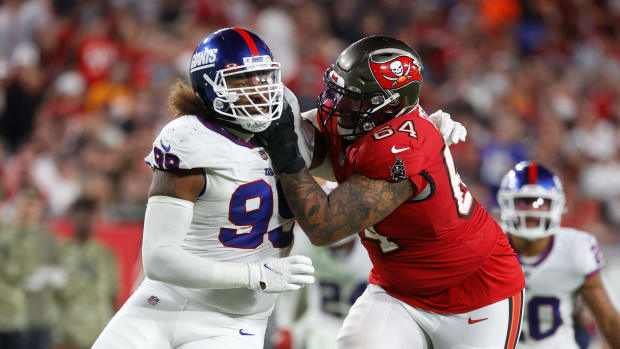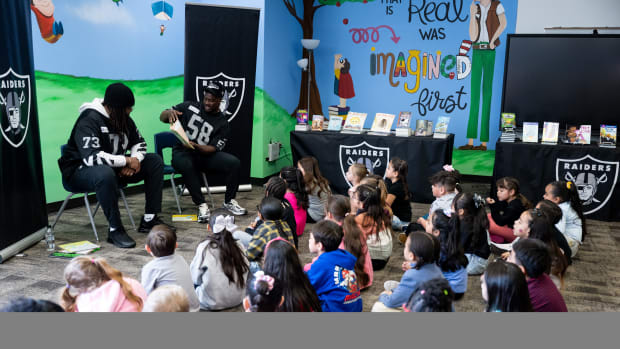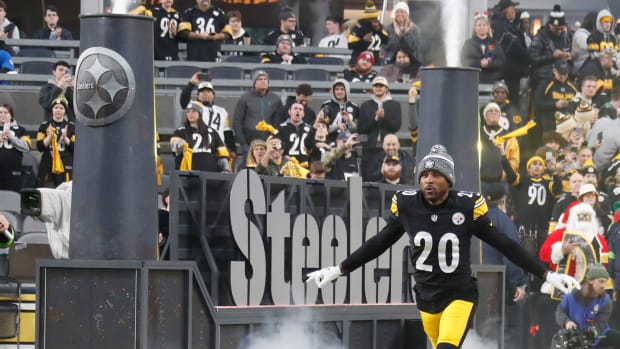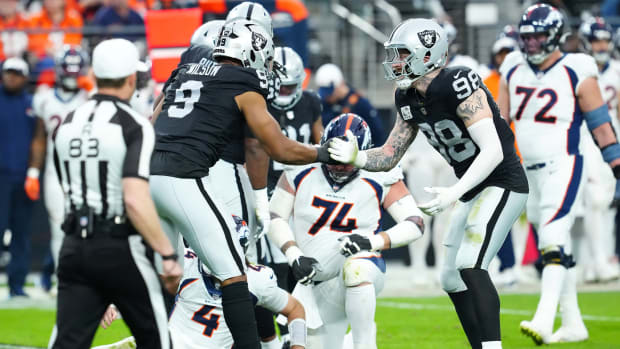The All-22: Watching tape and talking shop with Richard Sherman
RENTON, Wash. — Before I spent time watching game tape with Seahawks cornerback Richard Sherman on Thursday, I got a bit of insight into the pecking order of the Legion of Boom. Sherman and I climbed the steps to the second floor of the team’s facility after lunch and before practice. We headed to the defensive backs meeting room, only to find safety Earl Thomas in there, watching practice tape.
“Whatchu doin’?” Thomas inquired.
“We brought you some guests,” Sherman said. “We’re doing this tape thing.”
Silence. The tape still ran.
“But, we’ll go somewhere else.”
And so we did. Thomas is nine months younger than Sherman, but he’s the Godfather of the secondary. The Big Kahuna, in a way that’s been entirely earned with his amazing play, insane work ethic and complete focus. So, we walked to the tight ends meeting room and sat down to review tape of one of the best cornerbacks in the league.
Dan Quinn understands the struggle for sought-after coaches in playoffs
Everybody knows who Richard Sherman is, of course. He’s bold and mouthy, and he can back up just about everything he says. The Sherman I wanted to get to know was the Sherman who watches all kinds of tape to get that little extra intel on a receiver, who seems to have total recall of every snap he’s ever played. I wanted to get beyond the bombast and better understand the player who has been one of the best at his position and has stretches where he’s the league’s very best pass defender. I also want to know how that’s possible for a skinny former receiver selected in the fifth round out of Stanford in the 2011 draft.
And in truth, Sherman isn’t the same angry guy he was before. Whether it’s fatherhood or the five-year, $58.789 million contract with $40 million guaranteed he signed before the 2014 season, or simply heading into his late twenties, he has calmed down. There’s not so much “U MAD BRO?” and “DON’T YOU EVER TALK ABOUT ME!!!” and more pure leadership. Sherman understands that he is now to the younger defensive backs what others once were to him: a mentor and an example.
“When he first came, he was quiet,” Thomas told me about Sherman later in the day. “Then, he started to show this anger out of nowhere that seemed uncontrollable. He backed it up when he was out there. Now you just see him calm—he’s a dad now, family first. He’s not as loud, unless you bring something to the table, he’s going to strike back. I think he’s matured.”
How has Sherman developed as a player?
“Elevation. Every year we get better.”
• Wild-card previews:NFC | AFC | SHERMAN: Four ways to fix NFL officiating
It's hard to get better than Sherman was in 2013. That was the season in which he hit another stratosphere, like Deion Sanders in the early 1990s or Darrelle Revis in 2009. In 2013, Sherman led the league with a 36.2 passer rating allowed, allowing one touchdown and grabbing eight interceptions in 57 total targets. In 2014, he ranked third behind Denver’s Chris Harris and Indy’s Vontae Davis in opponent passer rating at 48.4, with one touchdown allowed and four picks in 65 targets.
Best-laid plans: How Texans crafted plays for their season's biggest game
This season started out with more difficulty for Seattle’s entire defense, and that showed in the team’s 2–4 start, but the Seahawks have certainly turned things around of late. Sherman ranked ninth in passer rating allowed at 68.0, allowing two touchdowns and picking off two passes on 64 targets. In the end, the 2012–15 Seahawks became the first NFL team since the Browns of the early 1950s to lead the league in scoring defense four seasons in a row. Given how different the passing game is now, it’s fair to say that what Pete Carroll’s team has done really has no precedent.
Another part of Sherman’s maturity is understanding and trusting that he can be himself. He says Carroll’s approach to treating every player as a unique individual pays unique dividends.
"A lot of people say that their coaches are more hard on them about what they say, who they are, how they dress for games, how they act in practice, how they act in meetings," Sherman recalled, when asked if he talks to other players around the league about their own coaches. “I couldn’t imagine working with some of these guys, honestly. It’d cause more strife than it would do good, I’m sure. There’s more than one way to skin a cat, as they say. I think some people forget that some people think this is the only way. You be hard on these guys, you be tough on them, you push them to their limits and then you get the result. I think Pete has found out through trial and error that there’s a different way that you can approach it.”
And in the interest of finding out how the Richard Sherman of today approaches things, it was time to sit down and discuss a few things—and then, it was time to turn on the tape.
Doug Farrar: First time I saw you was in your rookie minicamp in 2011, and I’m asking my colleagues, “Who’s the tall, skinny guy wearing No. 25, sticking onto receivers and knocking everyone on their asses?” What kind of cornerback were you when you came into the league?
Richard Sherman: I guess the same kind I am now. Aggressive press [coverage], man-up, stand-up. That’s how it’s always been, and that’s how it will always be.
DF: Could you point to a few moments in the first couple years in the NFL where the light went on and you had jumps in development beyond the normal curve?
RS: Honestly, not really. I think I’ve been pretty consistent. I’ve just gradually gotten better the more I’ve played. The more snaps you get, the more you see, the more you understand... over the years, that’s just the way it’s been.
Blanket Coverage: Who could emerge as unlikely postseason heroes?
DF:I didn’t bother putting too many fades and deep boundary throws in this piece, because you've been so lockdown on those for the most part, and you’ve been asked about that a lot. I asked [Seahawks then-secondary coach and current defensive coordinator] Kris Richard about it before Super Bowl XLIX, and he told a story about when Seattle scouted you at Stanford in a game against UCLA. Someone threw a fade, and we both just laughed. Like, “Why would you do that?” But in a general sense, why are you such an effective fade/boundary defender on deep routes, and what are your technical keys there? What would you tell a young defensive back who asked you how to be better against those routes?
RS: It’d be difficult, because a lot of kids have fear. And you can’t play this technique with fear. That’s why a lot of people don’t play it. Why a lot of people in the league don't play it, because they’re scared. Everybody’s afraid of the deep ball, that’s why [so few] teams play press-man coverage. They’ll play off, bail, do all that, because they’re scared of the deep ball. So, it’d be hard to teach young kids unless you have a fearless kid—otherwise, they won’t do it. It’s intuitive, it's in your mind. It's embedded in you when somebody’s running full speed at you, so it’s difficult. I’d tell them to develop some courage first.
DF: What makes you fearless?
RS: Confidence. Confident in knowing what I’m supposed to do, confident in my ability, and confident in who I am.
DF: You had eight picks in the 2012 and ’13 seasons, and those totals dropped to four last season and two this season. But it could be argued that you’ve played just as well through most of those two seasons. How can fans best understand the fact that interception totals are not the ultimate arbiter of coverage ability, in the same way that sacks aren’t the ultimate gauge of pass rushing? What makes a great cornerback great in a more general sense?
RS: Being consistent. Making an impact in each game. Not getting consistently beat. Not giving up touchdowns and getting your team behind. Showing up in big games. The game goes deep.
DF: What is the mentality of an “island” cornerback? How do you have to prepare yourself for the challenge inherent in defending one guy on your side of the field with not too much help? There are plays where you’re solo, on the wide side of the field, and there’s no other defender within 15 yards of you pre-snap.
RS: You just lock in and think about the game that way. You think about being alone and not having help. It’s you and him [the receiver], but you don’t think of it in a fearful, intimidated way. You think of it as a fun challenge. Something that will get your juices going—you don’t need any help, you don’t want any help. That’s what makes it such a challenge, and so unique, and why so few guys can do it.
Not everybody feels that way after you give up a catch. You give up a catch, or you give up a deep ball, they hit you with a really sudden move ... there’s only one of two ways you can go. Fold up and be scared, or let your nuts hang. Some people let their nuts hang, and some people fold up.
All-22: Cliff Avril and Michael Bennett break down the Seahawks’ pass rush
DF: Is it a matter of pride that you developed as a cornerback who follows other team’s top players in 2015, as opposed to staying on one side of the field no matter what?
RS: No. It’s always strictly coaches and whatever they ask. That’s how it’s always been, and anybody who says any different is a fool. I’ve yet to see a player make that kind of decision. There’s too much money involved in football, and too many jobs on the line, for players to make those decisions. Unless the coach says, “Go do it” ... If a coach tells me to go follow somebody, that’s what I’ll do.
DF: Which receivers present the most fun challenges to you?
RS: That’s a good question. I like covering Fitz [Larry Fitzgerald]...
DF: I knew you’d mention him!
RS: Antonio Brown, that was a real fun game. Calvin [Johnson] always presents unique challenges. A.J. Green, Julio Jones, I could go down the list, but those are some of the guys.
DF: What about Dez Bryant?
RS: Dez is definitely a fun guy to compete against. Unfortunately, he was kinda hurt and banged up a little bit this year, but you just appreciate their movement and preparation and everything they can do with their bodies and their body control. Route-running ... the more challenging it is, the more fun you’re having.
• MAYS: Vikings’ path to an upset | KLEMKO: DeSean Jackson unplugged
Play 1: Week 1 vs. Rams, 2015; 1:57 left in the first quarter
DF: Okay, I lied. I did include this vertical route: this long incompletion to Tavon Austin. On this play, you don’t have a boundary, and Austin has a step downfield before you recover and break it up. How are you able to anticipate routes so well? I’ve seen you run routes for receivers before, and I assume being a former receiver goes into that, and film study goes into that. How you do that is the general question, and what was your specific read on this play?
RS: On this play, I was reading run. Everything said run, and that’s what makes it difficult sometimes—that’s what the team does. Run 100 run plays out of the same formation, and one pass play out of that formation, and you’ll still have to cover it. That’s why everybody’s off [coverage] on that play, because everybody’s reading run, but you just have to adjust.
Off the Grid: Two views of Concussion, a Q&A with Leigh Steinberg and more
DF: So, you’re peeking into the backfield and splitting your focus to your receiver? Or how does that work?
RS: I’m reading through the quarterback. Through the line, through the quarterback, and through the receiver. And once Tavon kept going, I just stayed on top of him. He had a little step, but when he's throwing it that far, you have a little time to recover.
DF: How did you learn to chase a receiver through his moves that tightly? He’ll stutter or double-move, and you’ve learned to mirror receivers really well.
RS: Honestly, it’s instinctive. I couldn’t explain it if I wanted to. Sometimes, it’s just pure reaction and anticipation—anticipating he’s going to move this way, and he’s not going to move that way. Sometimes you guess right, and sometimes you guess wrong, but if you’re doing it right and you’re using your brain throughout the process, you’re usually right there.
DF: Using your brain is good.
RS:[Laughs] It’s definitely helped me.
• MAYS: Why three of the NFL’s best offense are throwing deep so often
Play 2: Week 3, 2015 vs. Bears; 14:03 left in the fourth quarter
DF: This is an interesting coverage here: You’re in what looks like bail coverage right on the line, in a bracket with linebacker K.J. Wright. When the ball is snapped, you take tight end Martellus Bennett up the field, and Wright takes Matt Forte out of the backfield. What’s the defense you’re playing here, and what’s your read? Is there a route combination that would have you switching with Wright in this case?
RS: It’s bail. We’re in Cover-3, and I have deep thirds, but I have to watch the running back. Because if the running back wheels out, he’s my responsibility. If he comes and takes off up the seam, he’s my responsibility. So, I have to be alert for that. I’m watching [Forte] at the start of the play, but I’m also alert for Martellus in my zone. As you know, I have a third of the field, so I’m trying to stay deep and get width to make sure I’m alert for him. Once [Forte] ran out, I had to go back and defend Martellus on the 7-cut.
DF:Did you play bail at all at Stanford? Because you’ve really improved with it in the NFL.
RS: Rarely. They made me play a lot more off coverage than anything else at Stanford—kinda playing against my strengths. But... y’know [smiles].
DF: Well, we won’t go into that.
Play 3: Week 13, 2014 vs. 49ers; 7:13 left in the fourth quarter
DF:I’ve talked with various receivers (including Doug Baldwin) about how important it is to alter their routes with a mobile quarterback who will move and extend plays outside of structure, and this interception of a Colin Kaepernick pass to Stevie Johnson is a really good example of how pass defenders must also alter their predetermined concepts when the play blows up and a quarterback is moving around. How does your focus change when the play devolves outside structure?
RS: Well, in this play, we’re up big, so I’m playing for the fade-stop route. And you have to stay over the top. When you see Kaepernick scramble, you don’t know if he’s going to chuck it out there or turn up and run, so you want to give him a little space. You don’t want to close it too quickly. I gave [Johnson] that space, and I saw him turn up. Most receivers in this league are taught, depending on your position on the field, if you're at the sideline, you sometimes turn up and just stop, and the ball will be on the way. So, I had to be alert for that. Once he turned up, I knew he’d go up and just stop, but he didn’t stop. That’s how our coaches teach it, that’s how their coaches teach it, that’s how Green Bay’s coaches teach it, because you can only have so many philosophies in a play, and that’s how I played it.
2016 NFL Mock Draft: With the order (mostly) set, who goes where?
DF: When you’re facing a mobile quarterback and a receiver on a deep route, how much are you focusing on the quarterback and whether he may bail, and how much can you read the receiver to know what the quarterback is doing? How much does it tell you when he’s sloughing off his route, and he has to go somewhere else?
RS: Once we got to the top of his route, he started stopping and looking like he was prepared to go up for the ball. You’ll see his body language. And I’m turned into him ... not just yet, but now.
I’m watching him, watching him ... he’s preparing to catch it, so I turned around. As he’s preparing, I need to prepare. I just felt that I’d be in a position to get a chance at it.
Play 4: Week 8, 2015 vs. Cowboys; 7:17 left in the third quarter
DF: So, the “Sherman in the slot” narrative seems a bit overblown at this point. 31 snaps and five targets this season, 19 snaps and seven targets in 2014, 27 snaps and five targets in 2013. Not a really big story, as it turns out.
RS:[Laughs] It’s a huge story!
DF: But this is a really interesting look, because Dez Bryant is basically uncovered in the slot—or, at least, it looks that way—and you crash down right away after he catches the ball, limiting the play for a three-yard loss. A lot of anticipation here. Is this as simple as “go where the ball goes,” or is there more to it than that? Are you trying to slow-roll him into thinking that he’s open short when he really isn’t?
RS: Something like that. That’s exactly what the coverage is meant to do, for teams like that. I don’t know if you know what “palms” is...
DF: Nope.
RS: It’s like ... they call it “Soft 2.” You have two receivers to your side. If “2” [the slot receiver] goes to the flat five yards or less, the cornerback takes him. If “2” goes vertical past five yards, the corner has man coverage on “1” [the outside receiver]. Since he went bubble [ran a bubble screen], that’s five yards or less, and you shoot your gun. I’m on “2” until he gets past this point, and then I’m on “1”. Which sounds easy until ... I still had to take a gamble on that play, because if I go underneath and I miss, he’s got at least 20–30 yards. Then, Earl will have to chase him down—it’d be a footrace between him and Dez. If I take that and [Bryant] blocks me, he’s up the seam.
DF: Well, Earl closes pretty quickly. Does anyone cover ground like he does?
RS. No. No, they don’t.
DF: I remember this play against the Rams in 2013 where Earl crashed down on the quarterback [Kellen Clemens] out of nowhere, and you could see the guy’s life flashing before his eyes.
RS: [Laughs] Yeah—he started to dive, like “Oh, my God!”
10 storylines for NFL playoffs: Victory droughts, lack of newcomers, more
DF: Outside defenders will talk about how hard it can be to transition to the slot—and at least within the league, there’s no sense that slot cornerback is some sort of demotion. Teams are running two-slots out of base and all that. The Cardinals do that a ton. How do you adjust to all of it: the lack of a boundary, the two-way goes, all that stuff that’s different? What are the biggest challenges when you move inside?
RS: Space. Space is the biggest difference. You don’t have the sideline anymore, but it brings you back to discipline and focusing on the receiver—his movements, his releases, because his releases still tell you the story. He’ll still tell you the majority of what’s going to happen. If he inside releases or outside releases, if he slow-plays it, if “1” is close, then he might be trying to pick you. You can still get a ton of information out of the formations.
Play 5: Week 16, 2015 vs. Rams; 6:49 left in the second quarter
DF: O.K., in the interest of fairness, I had to find a bad play. This one where you gave up a touchdown to Kenny Britt made me wonder a few things. Were you expecting help up top and you wound up trying to catch up? Did you slip? There’s a little stumble here as he makes his break after he presses? What’s going on here? Because this is odd.
RS: Oh, that was just bad footwork. I got a good jam [at the line], I was in good position, and then, I just had bad footwork. I guessed—I sat back-shoulder because the majority of the time when they’re in that formation, they run a comeback. And I sat for the comeback. It’s as simple as that.

























































